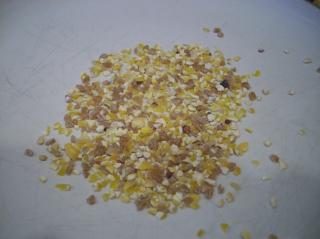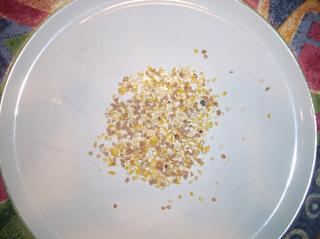I have two 6 week Americaunas, a 7 week Buff Orpington, and a 7 week White Leghorn. I've been feeding them only chick starter from day one. The feed store said to switch them to laying crumbles at 8 weeks, but I know everyone here says to wait until they are laying/about to lay. So I'm not sure what I should be feeding them when they turn 8 weeks. From researching the threads, it seems like most people feed either grower, start & grower, or flock grower. I haven't seen those at my feed stores. They only seem to have chick starter and laying crumble. Is chick starter the same as grower? Can I feed them chick starter until they are ready for laying crumble?
We'll hopefully finish the coop on Sunday and move them out there. We are in Northern California, so the weather is warm and they seem to have most of their feathers. The floor of the run is sand, so do I need to provide grit or can they just use the sand? I asked for chick grit at the feed store today and they don't sell any.
I also got them some chick scratch and BOSS today for treats. From researching the threads, it seems like I shouldn't give them the BOSS until they are about 16 weeks, is that true? Also, how do I give them the chick scratch? The particles are so small, almost like sand, if I throw them in the run with the sand I don't think they would find them. Should I put some chick scratch in a pie tin or bowl and put it out for them? The coop will have pine shavings on the floor, so I'm afraid that if I throw the chick scratch on the floor of the coop they wouldn't find it either.
Also, if I give them some fruit treats like watermelon, raisins, or cut up grapes, do I just throw them on the sand in the run? Or should I put them on a plate? As you can probably see, I'm having trouble wrapping my head around throwing food on the sand. If it was dirt I wouldn't have a problem for whatever reason, lol.
One last question. The feed store said to give them chick scratch and chick grit as treats from 8 to 20 weeks, then chicken scratch and chicken grit from 20 weeks on. Is that correct?
So the re-cap of my questions:
1. Is chick starter the same as grower?
2. Can I feed them chick starter until they are ready for laying crumble around 20 weeks old?
3. Do I need to provide grit or can they just use the sand that covers the run as grit?
4. When can I start feeding them BOSS for treats?
5. How do I give them chick scratch? On a pie plate or bowl or some other method?
6. How do I give them fruit for treats? Just throw them on the sand in the run?
7. Should I give chick scratch and chick grit from 8-20 weeks, and chicken scratch and chicken grit from 20 weeks on? As treats in addition to their feed, of course.
I've been researching for weeks with this forum and books and just can't seem to figure these questions out. Thanks for any advice!

We'll hopefully finish the coop on Sunday and move them out there. We are in Northern California, so the weather is warm and they seem to have most of their feathers. The floor of the run is sand, so do I need to provide grit or can they just use the sand? I asked for chick grit at the feed store today and they don't sell any.
I also got them some chick scratch and BOSS today for treats. From researching the threads, it seems like I shouldn't give them the BOSS until they are about 16 weeks, is that true? Also, how do I give them the chick scratch? The particles are so small, almost like sand, if I throw them in the run with the sand I don't think they would find them. Should I put some chick scratch in a pie tin or bowl and put it out for them? The coop will have pine shavings on the floor, so I'm afraid that if I throw the chick scratch on the floor of the coop they wouldn't find it either.
Also, if I give them some fruit treats like watermelon, raisins, or cut up grapes, do I just throw them on the sand in the run? Or should I put them on a plate? As you can probably see, I'm having trouble wrapping my head around throwing food on the sand. If it was dirt I wouldn't have a problem for whatever reason, lol.
One last question. The feed store said to give them chick scratch and chick grit as treats from 8 to 20 weeks, then chicken scratch and chicken grit from 20 weeks on. Is that correct?
So the re-cap of my questions:
1. Is chick starter the same as grower?
2. Can I feed them chick starter until they are ready for laying crumble around 20 weeks old?
3. Do I need to provide grit or can they just use the sand that covers the run as grit?
4. When can I start feeding them BOSS for treats?
5. How do I give them chick scratch? On a pie plate or bowl or some other method?
6. How do I give them fruit for treats? Just throw them on the sand in the run?
7. Should I give chick scratch and chick grit from 8-20 weeks, and chicken scratch and chicken grit from 20 weeks on? As treats in addition to their feed, of course.
I've been researching for weeks with this forum and books and just can't seem to figure these questions out. Thanks for any advice!




